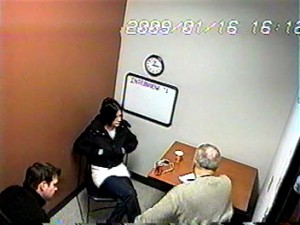The case for Melissa Causinski: Blinded with Science
Gregory Harutunian — December 14, 2015
Detectives Charles Curran (left) and George Filenko flank Melissa Calusinski, during a Jan. 16, 2009 nine-hour interrogation at the Lake Zurich police station. (Photo taken from interrogation tapes)
The is the second of two parts. Part 1 ran in the Dec. 9 issue of the McHenry Chronicle.
Armed with the main points of an alleged faulty autopsy report, an “unreadable” X-ray, and a videotaped confession, the Lake County state’s attorney’s office, under Michael Waller, obtained a first-degree murder conviction against former teacher’s assistant Melissa Calusinski in the death of 16-month-old Benjamin Kingan.
The Nov.2011 jury conviction has run its course through the appeals process, and returns Dec. 18 to the circuit court with evidence of alleged errors indicating a wrongful conviction. This second article relies on documents obtained by the Chronicle, through the freedom of information act, and updated statements.
Since 2010, there have been numerous verdicts overturned including six high-profile murder convictions. These reversals were largely due to coerced confessions obtained through members of the Lake County Major Crimes Task Force, the denial of science and DNA evidence, and in one case, the alleged manufacture of evidence.
These same reversals have resulted in multi-million-dollar settlements that ultimately become the burdens of taxpayers.
Autopsy reviewed
When Lake County Coroner Dr. Thomas Rudd assumed office in Dec. 2012, he was requested to review the original Kingan report by autopsy physician, Dr. Eupil Choi, from Jan. 14, 2009. Coinciding with the appellate consideration of Calusinski’s guilty verdict, his canvass developed over the next six months to a startling conclusion.
Correspondence between the two physicians shed light on a pre-existing injury: the bump on the anterior right side of the child’s head. It had been downplayed during the trial, where prosecutors elicited a somewhat confusing testimony from Choi, according to transcripts. With prompting, he said there was a skull fracture at the top of the cranium, as listed in his report, more than 30 times.
Rudd, in a May 15, 2013 letter to Choi, said, “After thoroughly reviewing your report and the transcripts of the trial … I believe there are changes in the brain more indicative of a chronic subderal hematoma. I got a second opinion from (former Cook County medical examiner) Dr. (Nancy) Jones, and she concurs with my impression.”
What had alerted Rudd?
“In viewing tissue sample slides of the subdural membrane … tests showed iron stain positivity from an area in the back, where an old injury was located. It had been hemorrhaging. When that happens iron goes to the wound as a healer, and creates a rust color.
“The other thing, which is huge … there was no skull fracture at the top, in the autopsy photos,” he said, in a phone conversation. “There were the meandering lines of the growth plates, where they fuse, and an accessory suture line, for layer removal, across the cranium top.”
Choi met with Rudd to assay the information, and his June 28, 2013 return letter to Rudd detailed a pre-trial review conference with lead prosecutor Christine Bishop, a representative of Paul DeLuca (Calusinski’s defense attorney), another pathologist, and himself that occurred Sept. 23, 2010.
Choi noted, “The tissue slide … was reviewed, it contained multiple fragments of the membranes. Among them a small fragment was found … it was thought to be a cellular structure of mesenchymal origin. It further revealed that it showed scattered positivity of the iron cells. I concurred … it was consistent with a subdural membrane and based on iron positivity.
“The trial was held Nov. 7, 2011. The microphotographs of the slide you showed me … were essentially similar (to) what I had viewed in 2010.”
That statement meant Choi was questioning his findings, prior to the trial. However, prosecutors went ahead with criminal litigation employing the skull fracture finding as tantamount to murder.
“I would ask that the state’s attorney (Michael Nerheim) do one thing … have a board-certified pathologist review the slides and the science of the case,” said DeLuca. “That’s the telling factor. They (the prosecutors) basically denied the entire slide histology and science of the case.”
Nerheim, upon taking office several years ago, convened a panel to review potential wrongful conviction cases.
“He actually looked at the Calusinski case, as one of the first cases to be reviewed,” said Cynthia Vargas, the State’s Attorney’s Office Communications Manager. “Both subsequent courts upheld the original jury’s verdict … he personally went through the entire file.”
Requests for comment from Nerheim were not returned.
Anonymous call
June 2015 brought another twist, with an anonymous phone call to Paul Calusinski, Melissa’s father.
“They said the child’s X-rays were in the coroner’s office,” said Rudd. “This is important … the X-ray of the child’s head presented at trial was clear, unreadable. When contrast gradients imbedded in the software are applied, it shows no skull fracture.”
An affidavit from coroner’s office employee, Paul Forman, substantiates that the X-ray was readable. “In Jan. 2009 … I took X-rays of Benjamin Kingan, including an X-ray of his head. I was present when Dr. Choi reviewed the X-rays and observed him (doing so). All the X-rays I took were clear and readable.”
At a “report of proceedings” hearing, held Sept. 7, 2011, two months before the trial began, Bishop stated, “It was discovered that there are in fact three X-rays that were taken. They are not readable or legible … They are very illegible on the digital (imaging), and they have only been tendered digitally.
“And we’re hoping that someone can assist us, and then the defense, in reading those X-rays, because the quality is not good.” At trial, the head X-ray was never shown with the contrast gradient, and remained “unreadable” to both sides.
Videotaped confession
Prosecutors did have a 9-hour videotaped confession of Melissa Calusinski. After she signed away her Miranda rights, detectives George Filenko, now commander of the Lake County Major Crimes Task Force, and Charles Curran, employed methods including behavioral analysis for character traits, the power of suggestion, fatiguing the subject, and the implication of promises to obtain a confession.
“It is true … once the Miranda rights are waived by the individual, they can lie to you, within reason,” said DeLuca.
Filenko makes the comment, also paraphrased by Dr. Choi, during the trial, “This is a serious injury … embarrassing, like he was dropped from the seventh floor of a building onto concrete.”
At one point, he screams at Calusinski and pounds the interview room desk.
Calusinski’s emotions are played upon, using her affection for the child with the suggestion of “dropping him,” accidentally. Five different scenarios for the death are offered by the interrogators, at different times, while she is distraught and crying, and left alone to “think about it.” At trial, the inference that Calusinski presented the five scenarios (stories) on her own, as proof of guilt, was forwarded.
A reenactment of the child’s autopsy, as if in real time, is also committed with interjections of being “dropped” as the only way to explain the child’s injuries. The word, “slammed,” is introduced and repeatedly mentioned by the officers. She denied harming the child more than 75 times through the course of the interrogation.
She relents on the tape, and begins agreeing with the interrogators. They ask her to demonstrate, several times, the manner in which she “dropped’ the child. Yet, the physical evidence, specifically the X-ray showing no skull fracture and medical data of a pre-existing injury, does not correlate to the admissions or depicted actions on tape.
Cause of death changed
The cause of death for Benjamin Kingan was officially changed, from homicide to undetermined, by Rudd, on July 23, 2015.
“The original pathology of acute injury is completely wrong. In fact, it is a chronic old injury that was from a bump on the head that was documented Oct. 27, 2008, by the daycare center,” he said. “New X-rays, from the coroner’s office, clearly show there was no skull fracture.”
Melissa Calusinski was not employed at Lincolnshire’s Minee Subee Day Care, where the death occurred, until November 2008. The injury and hemorrhaging had increased the child’s head size, from the 50th to 95th percentile, until the resultant death, more than three months later.
“In summary, the injury is old and the skull fracture is not there, which was the basis of the prosecution’s case,” Rudd said. “It is my opinion, that a re-investigation and a new trial is necessary.”
****
Paul Calusinski has remained steadfast, something that has taken a toll not only on himself, but on his family. “Knowing what we know today, that my daughter is innocent, she should be freed immediately. All the people involved with her criminal prosecution should step down right away.
“They should also apologize to the Kingan family, our family, and most of all, to my daughter, Melissa. It’s time for her to come home.”
First part in the series: Proving Melissa Calusinksi’s innocence
https://chronicleillinois.com/news/local-news/proving-melissa-calusinskis-innocence/
— The case for Melissa Causinski: Blinded with Science —







